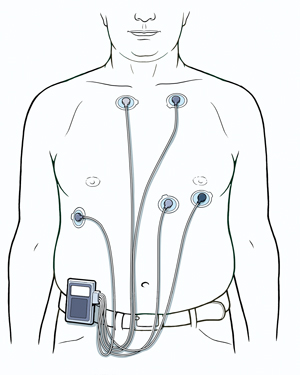A
B
C
D
E
F
G
H
I
J
K
L
M
N
O
P
Q
R
S
T
U
V
W
X
Y
Z
Topic IndexLibrary Index
Click a letter to see a list of conditions beginning with that letter.
Click 'Topic Index' to return to the index for the current topic.
Click 'Library Index' to return to the listing of all topics.
What Is Holter Monitoring?
Holter monitoring is a painless way to record your heartbeat away from your healthcare provider’s office. It's a small, battery-operated, portable electrocardiogram (ECG) machine. It may have wires that are put on your chest and a device to carry with you. It's about the size of a cellphone. Or it may be a patch monitor that does not require wires on the chest. Holter monitoring records your heartbeat for at least 24 hours. Your provider then reviews the information at a later time. You can get your Holter monitor at a hospital, test center, or provider’s office.
The monitor is used to record any problems with your heartbeat. It can show racing heartbeats, slow heartbeats, skipping heartbeats, fluttering heartbeats (palpitations), and fainting. All of these symptoms may be caused by an irregular heartbeat (arrhythmia). Holter monitors also provide information about your average heart rate throughout the day.

Your Holter monitor
When you get a Holter monitor, your healthcare provider puts small, sticky pads (electrodes) on your chest. These connect to the monitor by wires or leads. The monitor attaches to a belt or shoulder strap. Newer Holter monitors don't require wires or leads. They're placed directly over the heart with a sticky patch. You need to keep the device on for at least 24 to 48 hours or as advised by your provider. You also need to fill out a diary keeping track of any symptoms you may have during the monitoring period. Your provider will tell you how to do this.
While wearing the monitor, follow these tips:
-
Try to sleep on your back.
-
You can shower with a patch monitor, but not a wired monitor. Don't swim.
-
Follow your normal routine. Go to work and exercise as usual. It's important to record your heartbeat during your normal activities.
-
If an electrode or patch falls off or the unit makes noise, call your healthcare provider. Or call the phone number for device support to see what you should do.
-
When the monitoring period is over, you will return to your provider's office or an electrocardiogram center. Sometimes your monitor may be returned by mail. Make sure you know where to return your device. Once your provider receives the information from your monitor, it will be reviewed.
-
It may take about 1 week for the information to be looked at. Ask your provider if you should have a follow-up appointment or how you will get the results from your test.
When using a Holter monitor...
While wearing the monitor, stay away from things that may affect the recording, such as:
And don’t use machines with large motors or that cause vibrations. These can also affect the recording.
Keeping a Holter monitor diary
Keep a diary of things you do during the day. This is important. It could help you match your symptoms to times when your heart is beating abnormally.
-
Record the time of day for each entry you make.
-
Write down all activities. This includes when you take medicines, drive to work, take a nap, walk, sit down, exercise, or feel stress.
-
Note any symptoms you feel. These might be fluttering heartbeats or skipped beats, chest pain, back pain, nausea, or other symptoms. Write down any symptoms, even if you are not sure they are important.

Call 911
Call 911 right away if any of these occur:
Online Medical Reviewer:
Ronald Karlin MD
Online Medical Reviewer:
Stacey Wojcik MBA BSN RN
Online Medical Reviewer:
Steven Kang MD
Date Last Reviewed:
3/1/2024
© 2000-2024 The StayWell Company, LLC. All rights reserved. This information is not intended as a substitute for professional medical care. Always follow your healthcare professional's instructions.